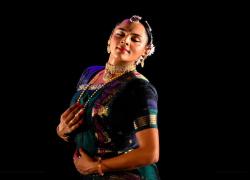Tabla Grooves and Kala Ramnath-Darbar Festival
10 October 2019
Milton Court Concert Hall, London
Reviewed by Ken Hunt
The annual Darbar Festival has grown steadily in importance, impact and outreach since it started life as the Darbar South Asian Music Festival in 2006. That first festival was a tribute to the tabla player Bhai Gurmit Singh Virdee (1937–2005). The tabla theme of the 14th Darbar Festival’s opening concert fit well. Auspiciously Tabla Grooves, a tribute to Pandit Shankar Ghosh (1935–2016), was performed on the Farukhabad gharana tabla maestro’s 84th birthday anniversary. That resourceful musician was part of the wave of tabla maestros who came of age in the 1960s. He joined the Ali Akbar College of Music in Marin County, California and even took part in a percussion summit during the Grateful Dead’s Berkeley Community Theater concert in September 1968.
Tabla Grooves was a tribandi (trio) concert by three of his disciples: Parimal Chakraborty, Kaushik Konwar and Gurdain Rayatt. Each had a three-drum set of two dāyāns and one bāyān (the bigger, left-hand drum). The set built in complexity with players building intensity or repeating phrases in their exploration of tonalities and sonorities with rhythmicalities, ringing tones and tihāis (threefold repetitions of a phrase) in a succession of tāl (rhythm cycle) sequences. Now, old-school tabla tarang (wave of tablas) involves tuning a count-on-the-digits-of-one-hand to a half-ring of tablas and is seldom practised the way Pandit Kamalesh Maitra (1924–2005) did it in living memory. For me, the trio’s fine fingerwork, rhythmic filigrees and heel pressure techniques had the best results when they demonstrated tabla tarang effects. Yet again and again, eyes shut in a self-imposed blindfold test, blinking open it was Parimal Chakraborty’s notes that were shining.
Kala Ramnath is one of sublimest contemporary interpreters in the Hindustani canon. Scion of a violin dynasty unique in the subcontinent, her grandfather Narayana Iyer put his violin-playing children on different paths. Her aunt Dr. N. Rajam took the Hindustani fork (as did her daughter, the remarkable Sangeeta Shankar) while her uncle T.N. Krishnan was directed to the Southern fork or style of violin playing. Part of Kala Ramnath’s initial particularity lay in her achieving escape velocity from her aunt’s gravitational pull. After her father’s death Ustad Zakir Hussain sat her down and, I paraphrase, told her the world didn’t need a N. Rajam clone. She ‘obeyed’. Steeped in melody, rhythm and tempo, of uttermost importance for her career trajectory was her wit to develop a singular voice all of her own. How she proved and delivered that at her return to the Darbar Festival after a 13-year hiatus was breath-taking, at times jaw-dropping.
Her violin was a copy of a Stradivarius made by the Chicago-based Polish-American Luthier Wladek (Walter) Stopka. In her possession since 2014 and strung with viola strings, she tuned her sweet-toned instrument ADAD instead of ADGC. She was accompanied by Pandit Yogesh Samsi, a shishya (disciple) of Ustad Alla Rakha Qureshi. His deftness of touch matched and reflected back her conjured moods. Plus, his feather-light, less-is-more approach reached the parts tabla gun-slingers’ playing seldom does. Kala Ramnath opened with a suite of her own compositions in rāg Jogkauns – a wedding vow composite rāg of Jog and Chandrakauns. Mirroring its version on Kala (Sense World Music, 2004), it had a short alap, followed by a slow composition in vilambit (slow) ektāl-12 beat cycle. During that opening movement she used the full length of the bow as upward or downward strokes. She slow-released plangent notes and extended glissando note clusters. A medium-tempo composition in the 14-beat ada chautal cycle followed before the suite climaxed with a rhythmic tarana piece in fast teentāl. The remaining pieces were shorter. Tilak Kamod was served with a 10-beat jhaptāl composition and a teentāl composition. The balance between coiled and unleashed energy in Yogesh Samsi’s playing here – and in the concluding piece in Bhairavi – is the sort of thing that only many years of playing can teach. He made an old man happy.
There was one an essential difference between the two recitals. One, a roughly 75-minute single piece of variations on themes and cycles found me giving up counting matra – beats – and instead counting minutes. In the other I lost all track of time. Darbar’s master of ceremonies Sandeep Virdee bade the audience farewell beautifully with “And with the music inside you, I bid you goodnight.”


















